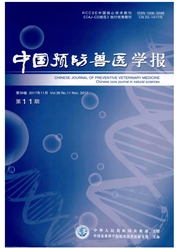

 中文摘要:
中文摘要:
为获得高效表达犬流感病毒(CIV)HA和NA抗原的疫苗株,本实验通过反向遗传操作技术将A/canine/Zhejiang/01/2010(H3N2)犬流感病毒(简称zJCrV)的HA和NA基因与A/PuertoRico/8/34(H1N1)病毒(PR8)的6个内部基因进行重组,拯救并获得了一株重组病毒CIV—PR8。分别用含100EID,0的CIV—PR8和ZJCIV感染SPF鸡胚,含2×10^3TCID。的C1V.PR8和ZJCIV感染MDCK细胞,不同时间段取病毒样品测定血凝效价和TCD,值。两者比较表明,CIV-PR8分别在接种后36h和48h时血凝效价达到峰值,鸡胚尿液中效价可达2^10,为野生病毒株的16倍;细胞上清血凝价可达2s,为野生病毒株的4倍;病毒增殖曲线表明通过鸡胚扩增和细胞扩增,CIV.PR8的滴度均高于野生病毒株ZJCIV。结果表明,拯救的CIV-PR8增殖能力明显高于野生病毒株ZJCIV,该重组病毒有望成为犬流感疫苗研制的候选病毒株。
 英文摘要:
英文摘要:
Canine influenza is a highly contagious disease caused by canine influenza virus (C1V). To enhance the expressions of hemagglutination (HA) and neuraminidase (NA) of C1V, a canine-human reassortant influenza viruses C1V-PR8 was generated by reverse genetic technique, which consisted of the segments encoding HA and NA from H3N2 subtype A/canine/ Zhejiang/01/2010 (ZJCIV) and 6 internal gene segments from A/Puerto Rico/8/34 (H1N1) virus (PR8). The rescued C1V-PR8 was identified by sequence analysis. Virus titrations showed that the HA titer of CIV-PR8 reached peak value of 2 in allantoic fluid within 36 to 48 hours which was 16 times higher than that of ZJC1V, and the HA titer was 28 in culture medium which was 4 times higher than that of ZJCIV when inoculated in chicken embryos with 100 EIDso and in MDCK cells with 2 x 103 TCIDso of CIV-PR8 and ZJC1V, respectively. The results suggested that reassortant virus of C1V-PR8 was a promising vaccine candidate for canine influenza.
 同期刊论文项目
同期刊论文项目
 同项目期刊论文
同项目期刊论文
 期刊信息
期刊信息
